西方文明之建筑(全英文介绍)
- 格式:ppt
- 大小:2.73 MB
- 文档页数:84
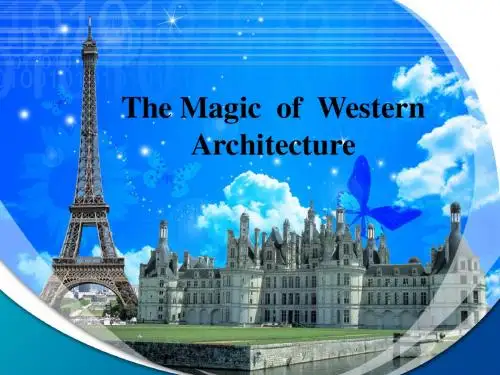
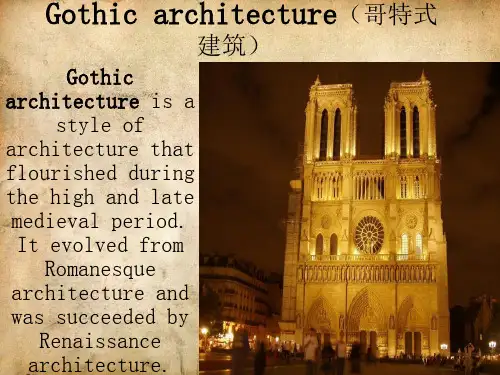
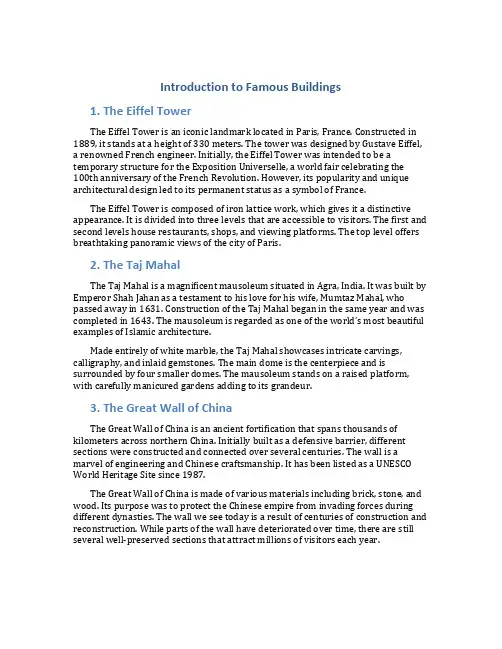
Introduction to Famous Buildings1. The Eiffel TowerThe Eiffel Tower is an iconic landmark located in Paris, France. Constructed in 1889, it stands at a height of 330 meters. The tower was designed by Gustave Eiffel, a renowned French engineer. Initially, the Eiffel Tower was intended to be a temporary structure for the Exposition Universelle, a world fair celebrating the 100th anniversary of the French Revolution. However, its popularity and unique architectural design led to its permanent status as a symbol of France.The Eiffel Tower is composed of iron lattice work, which gives it a distinctive appearance. It is divided into three levels that are accessible to visitors. The first and second levels house restaurants, shops, and viewing platforms. The top level offers breathtaking panoramic views of the city of Paris.2. The Taj MahalThe Taj Mahal is a magnificent mausoleum situated in Agra, India. It was built by Emperor Shah Jahan as a testament to his love for his wife, Mumtaz Mahal, who passed away in 1631. Construction of the Taj Mahal began in the same year and was completed in 1643. The mausoleum is regarded as one of the world’s most beautiful examples of Islamic architecture.Made entirely of white marble, the Taj Mahal showcases intricate carvings, calligraphy, and inlaid gemstones. The main dome is the centerpiece and is surrounded by four smaller domes. The mausoleum stands on a raised platform, with carefully manicured gardens adding to its grandeur.3. The Great Wall of ChinaThe Great Wall of China is an ancient fortification that spans thousands of kilometers across northern China. Initially built as a defensive barrier, different sections were constructed and connected over several centuries. The wall is a marvel of engineering and Chinese craftsmanship. It has been listed as a UNESCO World Heritage Site since 1987.The Great Wall of China is made of various materials including brick, stone, and wood. Its purpose was to protect the Chinese empire from invading forces during different dynasties. The wall we see today is a result of centuries of construction and reconstruction. While parts of the wall have deteriorated over time, there are still several well-preserved sections that attract millions of visitors each year.4. The Sydney Opera HouseThe Sydney Opera House is a renowned performing arts center in Sydney, Australia. Designed by Danish architect Jørn Utzon, it was inaugurated in 1973. This architectural masterpiece is considered one of the most distinctive and recognizable buildings of the 20th century.The Sydney Opera House consists of multiple performance venues, including concert halls, theaters, and studios. Its unique design comprises a series of spherical shells that form the roofs of the buildings. The white ceramic tiles covering the shells reflect light, giving the structure a stunning appearance against the backdrop of the Sydney Harbor.5. The ColosseumThe Colosseum, located in Rome, Italy, is an amphitheater built during the Roman Empire. Construction began in 72 AD and was completed in 80 AD. The Colosseum was primarily used for gladiatorial contests and various public spectacles such as mock sea battles.The oval-shaped amphitheater is an architectural marvel of ancient Rome. It was capable of seating around 50,000 spectators. The Colosseum features multiple levels, arches, and columns made of stone and concrete. Despite suffering damage from natural disasters and centuries of neglect, it remains an iconic symbol of the Roman Empire and attracts millions of visitors each year.In conclusion, these famous buildings around the world are not only architectural wonders but also hold great historical and cultural significance. Each structure showcases the talent and ingenuity of the architects and engineers who created them, leaving an indelible mark on the world’s architectural lan dscape.。
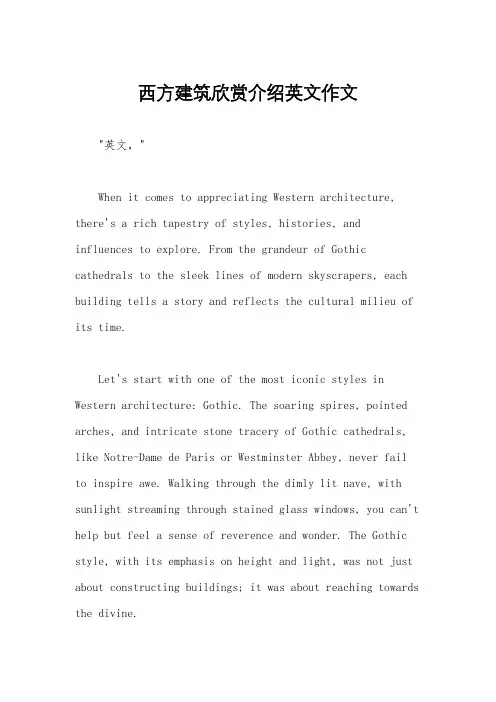
西方建筑欣赏介绍英文作文"英文,"When it comes to appreciating Western architecture, there's a rich tapestry of styles, histories, and influences to explore. From the grandeur of Gothic cathedrals to the sleek lines of modern skyscrapers, each building tells a story and reflects the cultural milieu of its time.Let's start with one of the most iconic styles in Western architecture: Gothic. The soaring spires, pointed arches, and intricate stone tracery of Gothic cathedrals, like Notre-Dame de Paris or Westminster Abbey, never fail to inspire awe. Walking through the dimly lit nave, with sunlight streaming through stained glass windows, you can't help but feel a sense of reverence and wonder. The Gothic style, with its emphasis on height and light, was not just about constructing buildings; it was about reaching towards the divine.Moving forward in time, we encounter the elegance of Renaissance architecture. Think of the symmetrical facades, domed roofs, and harmonious proportions of buildings like the Florence Cathedral or the St. Peter's Basilica in Vatican City. These structures embody the humanist ideals of balance, beauty, and rationality championed during the Renaissance period. Standing in front of the majestic dome of Florence Cathedral, designed by Brunelleschi, one can appreciate the ingenuity and skill of the architects ofthat era.Fast forward to the present day, and we find ourselves amidst the glass and steel jungle of modern architecture. Skyscrapers like the Empire State Building in New York or the Shard in London redefine our urban landscapes, pushing the boundaries of engineering and design. The sleek lines and futuristic forms of these buildings symbolize progress and innovation, reflecting the fast-paced nature of contemporary society.But it's not just the monumental structures thatcapture our imagination. Western architecture also encompasses charming townhouses, quaint cottages, and cozy cafes nestled along cobblestone streets. Whether it's the colorful facades of Amsterdam's canal houses or the charming balconies of Barcelona's Gothic Quarter, these smaller-scale buildings add character and warmth to their surroundings.In conclusion, Western architecture offers a diverse range of styles and influences, each with its own unique appeal. From the grandeur of Gothic cathedrals to the elegance of Renaissance palaces to the innovation of modern skyscrapers, there's something for everyone to appreciate and admire."中文,"谈到欣赏西方建筑,其中蕴含了丰富的风格、历史和影响。
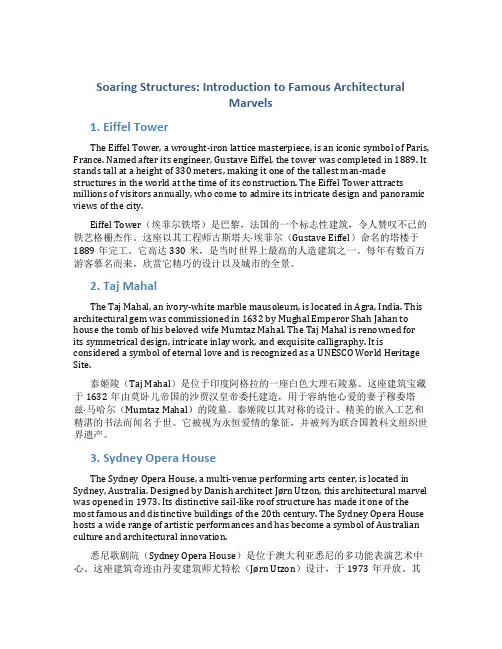
Soaring Structures: Introduction to Famous ArchitecturalMarvels1. Eiffel TowerThe Eiffel Tower, a wrought-iron lattice masterpiece, is an iconic symbol of Paris, France. Named after its engineer, Gustave Eiffel, the tower was completed in 1889. It stands tall at a height of 330 meters, making it one of the tallest man-made structures in the world at the time of its construction. The Eiffel Tower attracts millions of visitors annually, who come to admire its intricate design and panoramic views of the city.Eiffel Tower(埃菲尔铁塔)是巴黎,法国的一个标志性建筑,令人赞叹不已的铁艺格栅杰作。
这座以其工程师古斯塔夫·埃菲尔(Gustave Eiffel)命名的塔楼于1889年完工。
它高达330米,是当时世界上最高的人造建筑之一。
每年有数百万游客慕名而来,欣赏它精巧的设计以及城市的全景。
2. Taj MahalThe Taj Mahal, an ivory-white marble mausoleum, is located in Agra, India. This architectural gem was commissioned in 1632 by Mughal Emperor Shah Jahan to house the tomb of his beloved wife Mumtaz Mahal. The Taj Mahal is renowned for its symmetrical design, intricate inlay work, and exquisite calligraphy. It is considered a symbol of eternal love and is recognized as a UNESCO World Heritage Site.泰姬陵(Taj Mahal)是位于印度阿格拉的一座白色大理石陵墓。
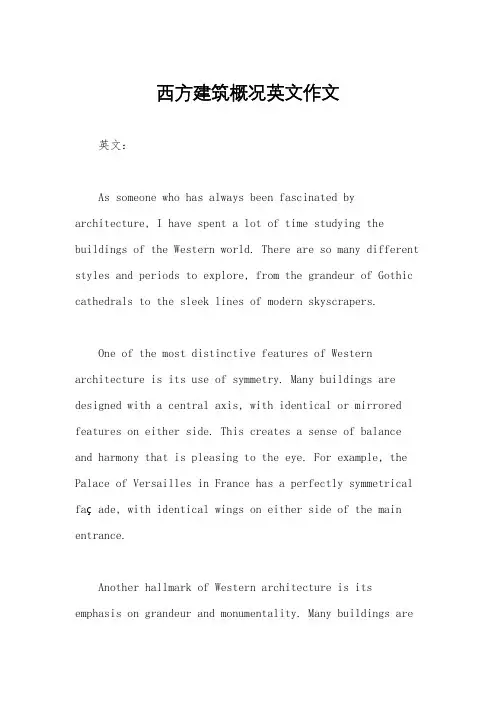
西方建筑概况英文作文英文:As someone who has always been fascinated by architecture, I have spent a lot of time studying the buildings of the Western world. There are so many different styles and periods to explore, from the grandeur of Gothic cathedrals to the sleek lines of modern skyscrapers.One of the most distinctive features of Western architecture is its use of symmetry. Many buildings are designed with a central axis, with identical or mirrored features on either side. This creates a sense of balance and harmony that is pleasing to the eye. For example, the Palace of Versailles in France has a perfectly symmetrical façade, with identical wings on either side of the main entrance.Another hallmark of Western architecture is its emphasis on grandeur and monumentality. Many buildings aredesigned to impress and awe their viewers, with soaring ceilings, ornate decorations, and imposing facades. The United States Capitol building in Washington, D.C. is a perfect example of this, with its massive dome and towering columns.Of course, Western architecture is not all about grandeur and symmetry. There are also many examples of more modest and practical buildings, such as the simple farmhouses of rural America or the functionalist designs of the Bauhaus movement. These buildings may not be asvisually striking as some of their more grandiose counterparts, but they are no less important in shaping the built environment of the Western world.中文:作为一个一直对建筑感到着迷的人,我花了很多时间研究西方世界的建筑。
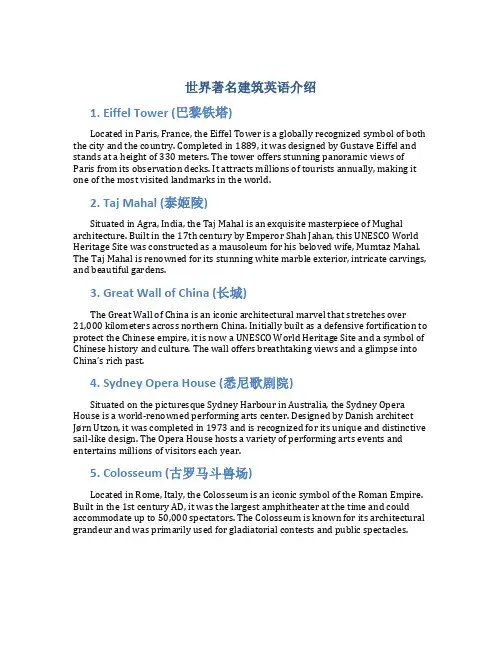
世界著名建筑英语介绍1. Eiffel Tower (巴黎铁塔)Located in Paris, France, the Eiffel Tower is a globally recognized symbol of both the city and the country. Completed in 1889, it was designed by Gustave Eiffel and stands at a height of 330 meters. The tower offers stunning panoramic views of Paris from its observation decks. It attracts millions of tourists annually, making it one of the most visited landmarks in the world.2. Taj Mahal (泰姬陵)Situated in Agra, India, the Taj Mahal is an exquisite masterpiece of Mughal architecture. Built in the 17th century by Emperor Shah Jahan, this UNESCO World Heritage Site was constructed as a mausoleum for his beloved wife, Mumtaz Mahal. The Taj Mahal is renowned for its stunning white marble exterior, intricate carvings, and beautiful gardens.3. Great Wall of China (长城)The Great Wall of China is an iconic architectural marvel that stretches over 21,000 kilometers across northern China. Initially built as a defensive fortification to protect the Chinese empire, it is now a UNESCO World Heritage Site and a symbol of Chinese history and culture. The wall offers breathtaking views and a glimpse into China’s rich past.4. Sydney Opera House (悉尼歌剧院)Situated on the picturesque Sydney Harbour in Australia, the Sydney Opera House is a world-renowned performing arts center. Designed by Danish architectJørn Utzon, it was completed in 1973 and is recognized for its unique and distinctive sail-like design. The Opera House hosts a variety of performing arts events and entertains millions of visitors each year.5. Colosseum (古罗马斗兽场)Located in Rome, Italy, the Colosseum is an iconic symbol of the Roman Empire. Built in the 1st century AD, it was the largest amphitheater at the time and could accommodate up to 50,000 spectators. The Colosseum is known for its architectural grandeur and was primarily used for gladiatorial contests and public spectacles.6. Petra (佩特拉古城)Situated in Jordan, Petra is an ancient city carved into the rose-red cliffs. Known as the。
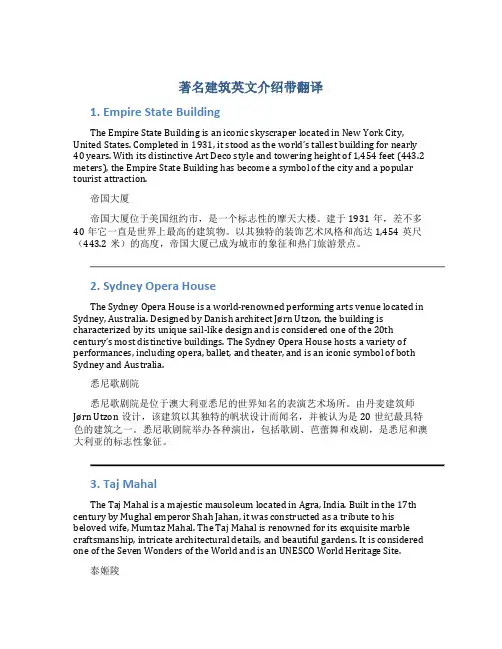
著名建筑英文介绍带翻译1. Empire State BuildingThe Empire State Building is an iconic skyscraper located in New York City, United States. Completed in 1931, it stood as the world’s tallest building for nearly 40 years. With its distinctive Art Deco style and towering height of 1,454 feet (443.2 meters), the Empire State Building has become a symbol of the city and a popular tourist attraction.帝国大厦帝国大厦位于美国纽约市,是一个标志性的摩天大楼。
建于1931年,差不多40年它一直是世界上最高的建筑物。
以其独特的装饰艺术风格和高达1,454英尺(443.2米)的高度,帝国大厦已成为城市的象征和热门旅游景点。
2. Sydney Opera HouseThe Sydney Opera House is a world-renowned performing arts venue located in Sydney, Australia. Designed by Danish architect Jørn Utzon, the building is characterized by its unique sail-like design and is considered one of the 20th century’s most distinctive buildings. The Sydney Ope ra House hosts a variety of performances, including opera, ballet, and theater, and is an iconic symbol of both Sydney and Australia.悉尼歌剧院悉尼歌剧院是位于澳大利亚悉尼的世界知名的表演艺术场所。
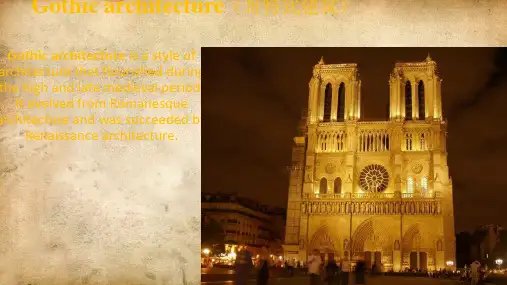
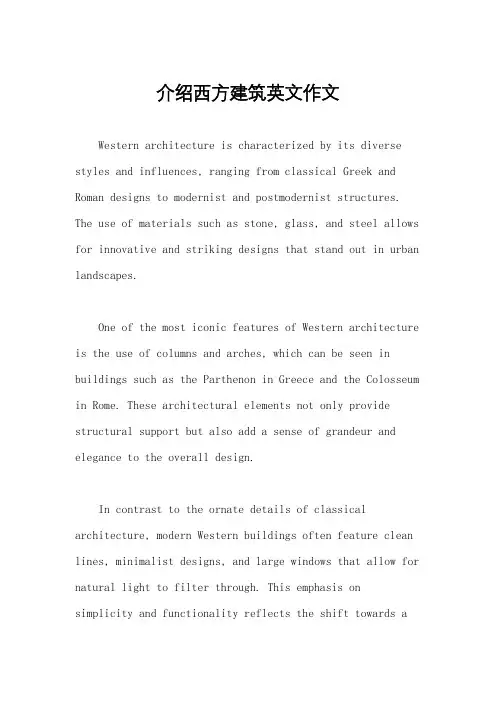
介绍西方建筑英文作文Western architecture is characterized by its diverse styles and influences, ranging from classical Greek and Roman designs to modernist and postmodernist structures. The use of materials such as stone, glass, and steel allows for innovative and striking designs that stand out in urban landscapes.One of the most iconic features of Western architecture is the use of columns and arches, which can be seen in buildings such as the Parthenon in Greece and the Colosseum in Rome. These architectural elements not only provide structural support but also add a sense of grandeur and elegance to the overall design.In contrast to the ornate details of classical architecture, modern Western buildings often feature clean lines, minimalist designs, and large windows that allow for natural light to filter through. This emphasis onsimplicity and functionality reflects the shift towards amore contemporary aesthetic in architectural trends.Postmodern architecture, on the other hand, embraces eclecticism and experimentation, combining elements from different styles and time periods to create visually dynamic and unconventional buildings. This approach challenges traditional notions of form and function, pushing the boundaries of what is considered "good" design.Overall, Western architecture is a reflection of the cultural, historical, and technological advancements of the societies in which it emerges. From ancient temples to futuristic skyscrapers, each building tells a story of innovation, creativity, and the ever-evolving nature of architectural design.。
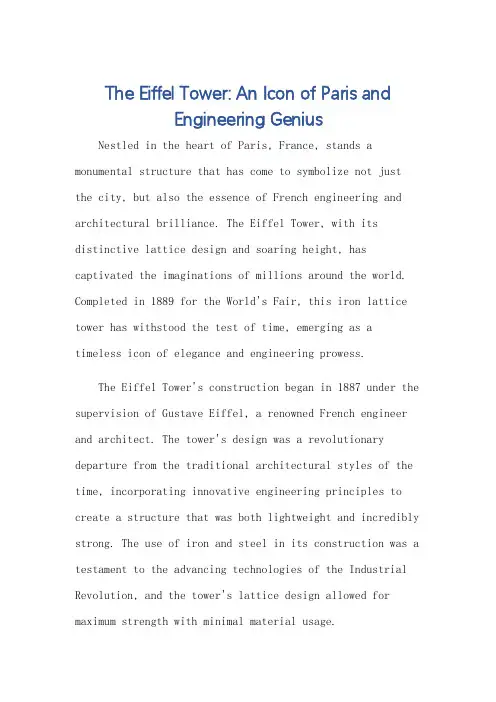
The Eiffel Tower: An Icon of Paris andEngineering GeniusNestled in the heart of Paris, France, stands a monumental structure that has come to symbolize not just the city, but also the essence of French engineering and architectural brilliance. The Eiffel Tower, with its distinctive lattice design and soaring height, has captivated the imaginations of millions around the world. Completed in 1889 for the World's Fair, this iron lattice tower has withstood the test of time, emerging as a timeless icon of elegance and engineering prowess.The Eiffel Tower's construction began in 1887 under the supervision of Gustave Eiffel, a renowned French engineer and architect. The tower's design was a revolutionary departure from the traditional architectural styles of the time, incorporating innovative engineering principles to create a structure that was both lightweight and incredibly strong. The use of iron and steel in its construction was a testament to the advancing technologies of the Industrial Revolution, and the tower's lattice design allowed for maximum strength with minimal material usage.The Eiffel Tower's four legs are anchored into a concrete base, with three levels of platforms providing breathtaking vistas of Paris. Visitors can take elevators or climb the stairs to reach the different levels, each offering a unique perspective of the city. The top level, reached by a separate elevator, offers a breathtaking 360-degree view of Paris, taking in the city's famous landmarks like the Notre-Dame Cathedral, the Arc de Triomphe, and the River Seine.The Eiffel Tower's impact on Paris and the world has been profound. It has become a symbol of love and romance, with many couples choosing to visit the tower and exchange vows at its base. The tower has also been a fixture in numerous movies and television shows, further cementing its status as a global icon.Despite its age, the Eiffel Tower remains a vibrant and active part of Paris's cultural and tourist landscape. It continues to attract millions of visitors from around the world, who come to marvel at its engineering feats, admire its timeless beauty, and experience the city of Paris from a unique perspective.**埃菲尔铁塔:巴黎的象征与工程奇迹**在法国巴黎的心脏地带,矗立着一座具有象征意义的建筑,它不仅代表着这座城市,还展现了法国工程和建筑的卓越才华。
介绍西方建筑英语作文Western architecture has a rich history that spans fromancient times to the modern era. It is characterized by a variety of styles, each with its own unique features and influences. Here is an essay that introduces Western architecture:Western Architecture: A Journey Through TimeWestern architecture is a testament to the ingenuity and creativity of human civilization. It has evolved through various periods, each leaving its indelible mark on the landscape of our built environment.Ancient Period: The BeginningsThe story of Western architecture begins with the ancient Greeks and Romans. The Greeks are known for their use of columns, which they employed in structures like the Parthenon, a temple dedicated to the goddess Athena. The Romans, on the other hand, were masters of engineering and introduced thearch and the dome, as seen in the Colosseum and the Pantheon. Medieval Period: Gothic and RomanesqueAs we move into the medieval period, we encounter theRomanesque and Gothic styles. Romanesque architecture is characterized by its massive walls, barrel vaults, and rounded arches, while Gothic architecture is known for its pointed arches, ribbed vaults, and flying buttresses, which allowed for taller and more open structures, such as the Notre-Dame Cathedral in Paris.Renaissance: A Revival of Classical IdealsThe Renaissance brought a revival of classical ideals. Architects like Brunelleschi and Michelangelo reintroduced the principles of symmetry, proportion, and harmony, which were evident in their designs for buildings like the Florence Cathedral and St. Peter's Basilica in Vatican City.Baroque and Rococo: Exuberance and EleganceThe Baroque and Rococo styles that followed were marked by their exuberance and elegance. Baroque architecture is known for its grandeur and dramatic use of light and shadow, as seen in the Palace of Versailles in France. Rococo, on the other hand, is characterized by its ornate decorations and playful asymmetry.Modern Era: Innovation and FunctionThe modern era of Western architecture began in the late 19th and early 20th centuries with the advent of new materials and technologies. Architects like Le Corbusier and Frank Lloyd Wright emphasized function and simplicity, creating buildings that were both practical and aesthetically pleasing, such asthe Villa Savoye and Fallingwater.Contemporary Architecture: Diversity and SustainabilityToday, Western architecture is characterized by its diversity and a focus on sustainability. Architects are exploring new materials, innovative designs, and eco-friendly practices, creating buildings that are not only visually striking but also environmentally responsible.In conclusion, Western architecture is a fascinating journey through time, reflecting the cultural, technological, and artistic changes of each era. It is a field that continues to evolve, with each new generation of architects adding their own unique contributions to the built environment.This essay provides a brief overview of the key periods and styles in Western architecture, highlighting the evolution of design and construction techniques from ancient times to the present day.。
西方建筑的英语作文Western architecture, with its rich history and diverse styles, has been a significant aspect of human civilization.It encompasses a wide range of architectural styles, from the ancient Greek and Roman structures to the modern skyscrapers that dominate today's cityscapes.The ancient Greeks are often credited with the foundation of Western architecture. Their temples, characterized by the use of columns and pediments, set the stage for the developmentof the Classical order. The Parthenon in Athens, with itsDoric columns and harmonious proportions, is a prime exampleof Greek architectural prowess.Moving on to Roman architecture, the Romans expanded upon Greek designs, adding their own innovations such as the arch and the dome. The Colosseum in Rome is a testament to their engineering skills, showcasing the grandeur and functionality of Roman structures.The Gothic period brought about pointed arches, ribbed vaults, and flying buttresses, which allowed for the construction of taller and more spacious buildings. The Notre-Dame Cathedralin Paris is a quintessential example of Gothic architecture, with its intricate stained glass windows and soaring spires.Renaissance architecture, a revival of classical ideals, emphasized symmetry, proportion, and geometry. The Pantheonin Rome, with its massive dome and oculus, is a masterpiece of Renaissance design.Later, the Baroque style emerged, characterized by its ornate details and dramatic use of light and shadow. St. Peter's Basilica in Vatican City is a prime example, with its grand scale and elaborate façade.The Industrial Revolution brought about a shift in architectural styles, with the rise of functionalist designs. The Crystal Palace in London, a cast-iron and plate-glass structure, was a symbol of the new age.In the 20th century, modern architecture took center stage, with architects like Le Corbusier and Frank Lloyd Wright pioneering new forms and materials. The Guggenheim Museum in New York, designed by Frank Lloyd Wright, is a prime example of modern architecture, with its spiral ramp and organic shapes.Today, contemporary architecture continues to evolve, with architects pushing the boundaries of design and technology. The Burj Khalifa in Dubai, currently the tallest building in the world, is a marvel of engineering and a symbol of modern ambition.In conclusion, Western architecture is a testament to human ingenuity and creativity. It is a living history that continues to evolve, reflecting the cultural, technological, and artistic shifts of each era.。
西方建筑欣赏介绍英文作文英文:When it comes to appreciating Western architecture,there are a few key things to keep in mind. First and foremost, it's important to understand the historical context and cultural influences that shaped the particular style of architecture you're looking at. For example,Gothic architecture was heavily influenced by the religious beliefs and artistic traditions of medieval Europe, whileArt Deco was a product of the modernist movement and therise of industrialization.Another important factor to consider is the use of materials and construction techniques. Western architecture has a long history of using stone, brick, and other durable materials to create buildings that can withstand the testof time. Additionally, many Western architects have experimented with new construction techniques and technologies, such as reinforced concrete and steel framing.Finally, it's important to appreciate the aesthetic qualities of Western architecture. From the grandeur of a Gothic cathedral to the sleek lines of a modernist skyscraper, Western architecture offers a wide range of styles and designs to admire. Whether you prefer the ornate details of a Baroque palace or the minimalist simplicity of a Bauhaus building, there's something for everyone to appreciate.中文:欣赏西方建筑,需要注意一些关键因素。
The Eiffel Tower: An Icon of Paris andEngineering MarvelNestled in the heart of Paris, France, stands a tower that has become synonymous with the city itself—the Eiffel Tower. This iron lattice tower, named after its designer, Gustave Eiffel, is not only a symbol of Paris but also a remarkable feat of engineering. Completed in 1889 for the World's Fair, the Eiffel Tower has since become a popular tourist attraction, drawing millions of visitors every year. The Eiffel Tower's design was revolutionary for its time. Eiffel's use of iron and steel, rather than the traditional masonry, allowed for a lighter and moreflexible structure. The tower's lattice design also maximized strength while minimizing material usage. These innovations not only showcased the latest in engineering technology but also pushed the boundaries of what was possible in architecture.The Eiffel Tower's impact on Paris and the world is immeasurable. It has become a global icon, recognized by people from all corners of the globe. Its distinctive shape and elegant lines are instantly recognizable, making it asymbol of France and Paris. The tower has also become a symbol of love, with many couples choosing to visit the tower and even get married there.The interior of the tower is equally as fascinating as its exterior. Visitors can take elevators or climb the stairs to reach the observation decks, where they can enjoy panoramic views of Paris. The tower also features restaurants and even a Champagne bar, allowing visitors to enjoy their experience even further.The Eiffel Tower's influence extends beyond tourism. It has been a key part of numerous cultural and historical events, including the centennial of the French Revolution and the centenary of the First World War. The tower has also been used as a radio and television broadcast tower, as well as a platform for scientific experiments.The Eiffel Tower's legacy is one that will endure for generations. Its unique design, engineering prowess, and cultural significance have made it a timeless icon. As Paris continues to evolve and change, the Eiffel Tower remains a constant, a reminder of the city's rich history and unwavering spirit.**埃菲尔铁塔:巴黎的标志与工程奇迹**在法国巴黎的心脏地带,矗立着一座与这座城市本身同名的建筑——埃菲尔铁塔。
Ancient Greek architectureIn Western culture, we commonly associate ancient Greek architecture with dramatic pillars in the front of a home or other building. Yes, it’s one of its features. Ancient Greek architecture dates to 400 BC. The style of architecture spread throughout other regions of the world and became popular in Europe in the mid-1700s. It commonly featured a front and back porch, which is where the columns were displayed. It is categorized by three different styles (also called orders). The three orders are known as the Doric, Ionic and Corinthian. The ancient Greek architectural style is significant because it promotes harmony and proportion in its design.Here are some picturesRoman architectureRoman architecture,which is famous for the symmetry of the building and the magnificent, is a continuation of ancient Greece architecture. Roman architecture is generally characterized by thick masonry walls, semi-circular arch, layer by layer to single out the door frame decoration and cross-vaulted structure. It reached its peak is in the 1~3 century when it achieved the peak of Western architecture. The Colosseum, its master work, was built in AD72-82.Now its Site is located on the Italian capital of Rome city center. For its history, it is a symbol of the ancient Roman civilization. It was round; but overlooking, it is oval.Byzantine architectureByzantine architecture is the building style of Constantinople after ad 330. Byzantine architects were compromise, at first drawing heavily on Roman temple features. Their combination of the basilica and symmetrical central-plan religious structures resulted in the characteristic Byzantine Greek-cross-plan church, with a square central mass and four arms of equal length. The most distinctive feature was the domed roof. Such structures have in common the predominance of a central domed space, flanked and partly sustained by smaller domes and half-domes spanning peripheral spaces.Gothic architectureGothic architecture is a style of architecture that flourished during the high and late medieval period. It dated back to 12th century in France and lasting into the 16th century, Gothic architecture was known during the period as “the French Style”, with the term Gothic first appearing during the latter part of the Renaissance.Its characteristic features include the pointed arch, and the flying buttress, stained windows.Rococo architectureRococo architecture was a variation of baroque. It began in the eighteenth century. It was lighter, more graceful, and more subdued than baroque architecture. Most of the rococo decorations were natural forms such as tree branches, clouds, flowers, sea shells, seaweed, and scrolls. Many colors that were used were pastels, but they also used lots of gold.Most rococo rooms were rectangular with rounded corners, and the walls were mostly flat, and smooth. Doors and woodwork had minor carvings. The often had decorations and gilding on the walls, doors, and draperies. Windows, wall panels, and doors often went all the way from the floor to the ceiling. Mirrors were also common.。
介绍西方建筑英语作文Title: Exploring Western Architecture。
Architecture is not merely a structure of bricks and mortar; it embodies the spirit, culture, and history of a civilization. Western architecture, spanning across centuries, has left an indelible mark on the world with its diverse styles, innovations, and iconic landmarks. In this essay, we delve into the rich tapestry of Western architecture, tracing its evolution, key characteristics, and notable examples.Ancient Greek Architecture:Western architectural heritage finds its roots in ancient Greece, where the principles of harmony, proportion, and balance laid the foundation for architectural design. The hallmark of Greek architecture is the temple, characterized by its Doric, Ionic, or Corinthian columns supporting a pedimented roof. The Parthenon, an enduringsymbol of classical architecture, epitomizes the grandeur and symmetry of Greek temples.Roman Architecture:Building upon Greek precedents, Roman architecture fused innovation with engineering prowess. The Roman arch, vault, and dome revolutionized architectural construction, enabling the creation of colossal structures such as the Colosseum and the Pantheon. Roman aqueducts stand as marvels of ancient engineering, showcasing the mastery of arches and concrete.Gothic Architecture:In the Middle Ages, Europe witnessed the rise of Gothic architecture, characterized by soaring spires, pointed arches, and ribbed vaults. Cathedrals like Notre-Dame de Paris and Chartres Cathedral exemplify the ethereal beauty and spiritual aspirations of Gothic design. The intricate stained glass windows of Gothic cathedrals flood interiors with kaleidoscopic light, evoking a sense of divinetranscendence.Renaissance Architecture:The Renaissance witnessed a revival of classical ideals, leading to a rebirth in architectural innovation. Inspired by the works of Vitruvius and the rediscovery of ancient texts, Renaissance architects pursued symmetry, proportion, and humanism. The iconic dome of Florence Cathedral, designed by Filippo Brunelleschi, epitomizes the fusion of classical principles with technological ingenuity.Baroque Architecture:Baroque architecture, flourishing in the 17th and 18th centuries, embraced dramatic ornamentation, illusionistic effects, and dynamic movement. Palaces, churches, and royal residences across Europe bear the hallmark of Baroque extravagance. The Palace of Versailles, with its opulent halls, meticulously landscaped gardens, and grandiosefaçade, epitomizes the grandeur and excesses of the Baroque era.Neoclassical Architecture:Amidst the Enlightenment ideals of reason and rationality, Neoclassical architecture emerged as a returnto classical forms and ideals. Inspired by the archaeological discoveries of Pompeii and Herculaneum, Neoclassical buildings exude a sense of order, simplicity, and proportion. The United States Capitol in Washington D.C. and the British Museum in London exemplify the Neoclassical revival in civic and cultural institutions.Modern Architecture:The 20th century witnessed a radical departure from tradition, as architects embraced new materials, technologies, and ideologies. Modernism, characterized by functionalism, minimalism, and abstraction, rejected ornamentation in favor of rational design. The Bauhaus movement, led by figures like Walter Gropius and LudwigMies van der Rohe, epitomized the modernist ethos of form following function.Contemporary Architecture:Contemporary architecture reflects the diversity and dynamism of the modern world, embracing eclecticism, sustainability, and cultural diversity. Architects like Frank Gehry, Zaha Hadid, and Renzo Piano push the boundaries of design with avant-garde structures that defy convention and challenge perception. From the Guggenheim Museum Bilbao to the Burj Khalifa, contemporaryarchitecture continues to redefine the urban landscape.In conclusion, Western architecture stands as a testament to human creativity, ingenuity, and cultural heritage. From the temples of ancient Greece to the skyscrapers of the modern era, each architectural style reflects the values, aspirations, and aestheticsensibilities of its time. By understanding the evolution and diversity of Western architecture, we gain insight into the enduring legacy of human endeavor and imagination.。